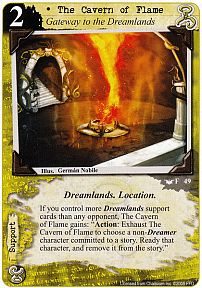19. Chambers of Fire

19. Chambers of Fire

|
|
|
|
|
|
|
|
|
|
|
|
Geography: These caves
are very close to the fiery geothermal
heat sources that constantly
bake this portion of Deepearth.
Although the caves were
originally formed by water eroding the
natural stone of the area,
the small amount of water that now
flows into these caves is
quickly evaporated by the blistering
heat.
The tunnel leading into the
Chambers of Fire area was a naturally
formed cave that once contained
a sizable stream. Heat
issuing from fissures in
the caves has long since dried up any
vestiges of flowing water.
The tunnel has been swept clean by frequent
blasts of tremendous heat,
and is devoid of cave formations.
The temperature in the approach
tunnel is so hot that
creatures not resistant
to fire sustain 1d6 points of damage per
turn. If characters take
protective measures, such as frequently
dousing themselves with
water, they can avoid this damage.
The caves have formed as
a number of large, roughly circular
caverns connected by an
assortment of artificial and natural tunnels.
Each of the large caves
is split by a few long, narrow fissures
in the floor. These fissures
are thousands of feet deep, and
often belch out blistering
clouds of smoke, poisonous gas,
steam, and fire. An eruption
of one of these substances (25%
chance for any given type)
occurs an average of once per hour in
each cavern. The eruption
lasts for 1d6 rounds.
The average temperature in
each of these caves is dangerously
hot by human standards.
Creatures not resistant to fire suffer
1d6 points of damage per
round here. Protective measures
such as the water dousing
mentioned above reduce this damage
to half, but do not eliminate
it entirely.
If an eruption from one of
the fissures occurs while characters
are in the cave, mundane
protective measures are to no avail. If
steam or fire erupts, characters
in the cavern sustain 6d6 points
of damage per round, with
a saving throw vs. breath weapon
reducing this to half damage.
If poison gas erupts, a saving throw
vs. poison is necessary
to avoid death. Smoke eruptions fill
the
cave for 1d4 turns, with
the effects described on page 36.
There is a 50% chance that
a given fissure (3d6 feet wide) is
bridged in at least one
spot by a slender stone arch.
Denizens: Most earthly
creatures are unable to survive in the
fiery environment of these
caverns. Three types of unearthly
creatures do reside in the
area, however.
Mephits
are the most common denizens here, and are represented
in all four of their forms:
fire,
lava,
smoke,
and steam.
Mephits are 50% likely to
be encountered immediately following
an eruption of the appropriate
type. Lava mephits are associated
with poisonous gas eruptions
for this purpose.
These creatures are generally
sent to the Prime Plane to
accomplish some fiendish
or demonic purpose, although it
seems that the mephits frequent
this area simply because they
like it. Of course, if humans
or other earthly creatures are
encountered, the mephits
cheerfully attack. Only in the remote
cavern (described under
Unique
Features) do these infernal
creatures seem to pursue
a goal.
Fire
bats are also common among these caves. They flap
about the area, swooping
adroitly into and out of the fissures.
Occasionally, the fire bats
extend their flights into the caverns
approaching the area, but
they do not remain away from their
fiery heat sources for long.
The third heat-loving denizens
of the area are groups of
magmen.
Their principal activity is climbing the sheer walls of the
fissures from the furnaces
below so that they can joyously leap
back down, plummeting thousands
of feet to splash into the molten
rock below. The magmen spend
several days making the
laborious climb just for
the fun of the dive back down. They
eagerly attempt to ignite
any creatures or unusual objects they
encounter while in the caves,
not out of maliciousness, but to
gratify their other-worldly
sense of fun. The magmen would enjoy
persuading other creatures
to participate in their diving game,
but so far they have found
no takers.
Resources:
This smoky, flaming group of caverns has few
resources useful to surface
dwellers. Any water that flows into the
area is quickly sizzled
into steam by the ferocious heat. The air
itself is smoky, smells
bad, and occasionally becomes poisonous.
The caverns do have a series
of narrow fissures in their ceilings
through which most of the
foul air can escape, so enough fresh
air flows into the area
to make the atmosphere breathable. Mildew
has formed in some of the
cooler out-of-the way places here,
but this is the only form
of plant life in the area.
Unique
Features: The largest fissure is located in the area’s
most remote cavern. It is
here that the mephits diligently toil.
When eruptions occur from
this fissure, 21-40 mephits
(1d20+20) of the appropriate
type enter the cavern with the first
shock of the eruption. They
aggressively toil to widen the fissure
from its current width of
20 feet by chipping away at the walls with
an assortment of superhardened
metal tools. A number of these
tools are lying about the
cavern. They resemble small pickaxes
with stone handles and metal
picks, and are completely irnpervious
to fire.
The mephits delight in attacking
any intruders in this area, but
instead of killing them
outright, they are dragged to the fissure
and thrown in as offerings.
The mephits are attempting to widen
the fissure enough to allow
the passage of a monstrously evil
creature from one of the
dark lower planes. They have been toiling
for many years, and will
continue to do so until they achieve
their goal, or a major catastrophe
(earthquake, cave-in, etc.)
occurs and seals the fissure.